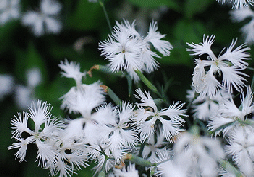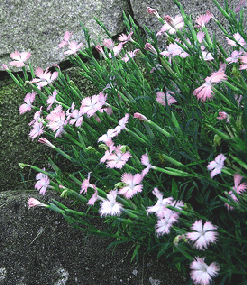Dianthus Pinks
Dianthus species variations, the Pinks
The Dianthus genus includes hardy perennials most notably the “pinks” (Dianthus superbus), as well as biennials and short lived perennials such as the Sweet Williams (Dianthus barbatus), and annuals. Carnations (Dianthus caryophyllus) are also a part of the Dianthus genus, some are hardy and some are not. In northern gardens, some Dianthus can only be grown as annuals. Select your Dianthus carefully to be sure you are getting a hardy perennial.
Superbus is the subspecies that includes the “pinks”. Dianthus superbus are referred to as the Garden Pinks or Wild Pinks. Pinks are easy to grow and very hardy. Dianthus plumarius are ‘Feathered Pinks’ and heirloom pinks referred to as Large Pinks, very hardy and difficult to find. Dianthus gratianopolitanus are the Cheddar Pinks. Dianthus deltoides are Maiden Pinks. Dianthus monspessulanus are Fringed Pinks. Dianthus chinensis are the China Pinks. And then of course, there are the hybrids. Once planted in well drained soil with plenty of sun, occasional water and division every few years is about all they need. Cottage garden pinks are excellent low growing, prolific bloomers for the front of a border, rock garden or edging.
Dianthus superbus blooms are five petaled with green eyes. The petals are deeply notched giving them a feathery or fringed appearance, leading them to be commonly called Fringed Pinks as well as Large Pinks. Multitudes of lacy blooms are produced in clusters from June to August. A tall Dianthus, the species superbus grows up to 15” high. Although a neutral to alkaline soil is preferred, superbus will tolerate slightly acidic soil. Longicalycinus and speciosus are species variations, ‘Crimsonia’ is a cultivated variety. Hybrids have also been developed, found marketed as ‘Supra Dianthus’. These are cross species hybrids, that preserve the strength and vigor of the species while improving heat tolerance and blooming. Superbus are highly fragrant, the scent is both fruity and powdery.
Dianthus superbus var. longicalycinus, speciosus
Common Name: Large Pinks, Fringed Pinks, Wild Pinks
Plant Type: Herbaceous evergreen perennial
Height: 6-12”
Spread: 9-12”
Sun/Shade Requirements: Full sun
Water Requirements: Very adaptable but prefers average watering, do not over water.
Soil Requirements: Soil must be well drained, prefers neutral to alkaline pH. Will tolerate most soil conditions.
Growth Habit: Loosely tufted clumps
Bloom Time: May through July, repeating through September
Bloom Color: Pink, white or lavender
Bloom Form: 1” single blooms with five broad petals notched at the outer edges.
Foliage: Very narrow gray-blue green leaves with pointed tips.
Fragrance: Highly fragrant
Pest and Disease Resistance: Susceptible to crown rot if over watered or if soil is poorly drained.
Fertilize: Spicy scent.
Maintenance: Divide in spring or fall.
Other: Attracts butterflies and hummingbirds. Deer resistant.
Hardiness: Zones 3-0
The superbus var. longicalycinus is commonly grown in Japan, Korea, China and Taiwan and when grown in North America they are usually grown from seed or cuttings. This species variation is often referred to as Wild Pink or Superb Pink. They would be an excellent addition to any cottage garden, wildflower garden or woodland garden if you can find a seed source (try Annie’s Annuals online). As a species plant longicalycinus and speciosus are tough, vigorous and adaptable, requiring virtually no care.
The variation speciosus, which is synonymous with spp. alpestris, is quite similar and a seed source is easier to find. The flower stems rise up to 30 inches and the blooms are a bit larger, about 1 1/2”. The flowers are normally pink, but sometimes white. The petals are even more deeply cut on speciosus. Both are strongly fragrant.
Dianthus superbus ‘Crimsonia’
Common Name: Large Pinks, Fringed Pinks
Plant Type: Herbaceous evergreen perennial
Height: 18-24”
Spread: 18-24”
Sun/Shade Requirements: Full sun
Water Requirements: Very adaptable but prefers average watering, do not over water.
Soil Requirements: Soil must be well drained, prefers neutral to alkaline pH. Will tolerate most soil conditions but prefers loose sandy soil.
Growth Habit: Loosely tufted clumps
Bloom Time: June through July, repeating through September
Bloom Color: Crimson red
Bloom Form: 2 1/2” single blooms with five broad petals deeply notched at the outer edges.
Foliage: Very narrow 3” green leaves with pointed tips.
Fragrance: Strong spicy clove scent
Pest and Disease Resistance: Susceptible to crown rot if over watered or if soil is poorly drained.
Fertilize: Apply a balanced 10-10-10 fertilizer in early spring and again after the first blooming. Or top dress with organic compost in spring and fall.
Maintenance: Divide in spring or fall.
Other: Attracts butterflies and hummingbirds. Deer resistant.
Hardiness: Zones 3-8
Like it’s superbus namesake, ‘Crimsonia’ is a robust plant that is tough and easy to grow. The flower stems are upright and strong, branched at the upper end to hold small bouquets of exquisite blooms. The petals are deeply cut and give a lacy fringed appearance. The blooms are huge by dianthus standards, and these rich crimson red flowers will make a big impact. Shear the stems when blooms are spent to encourage the next blooming. The long stems and wonderful fragrance are ideal in a vase. ‘Crimsonia’ is drought resistant, but will want supplemental watering during hot dry periods. Do not over water, and make sure your soil is well drained. ‘Crimsonia’ should live 3-5 years, divide to produce new plants to extend longevity. Since they grow quite easily from seed, many gardeners simply plant more seed to increase numbers.



